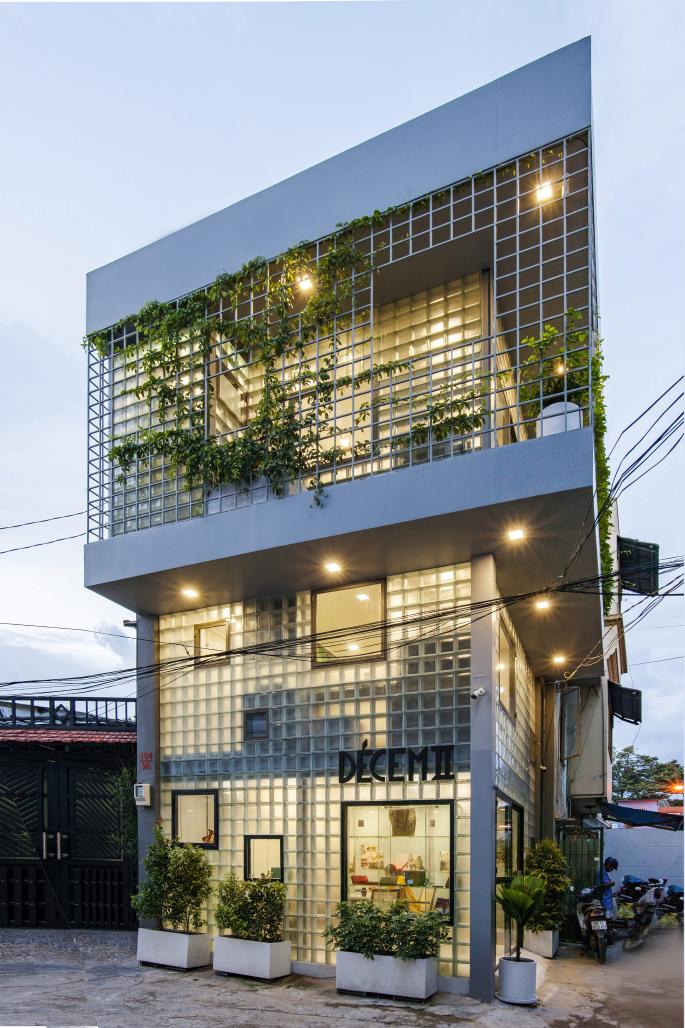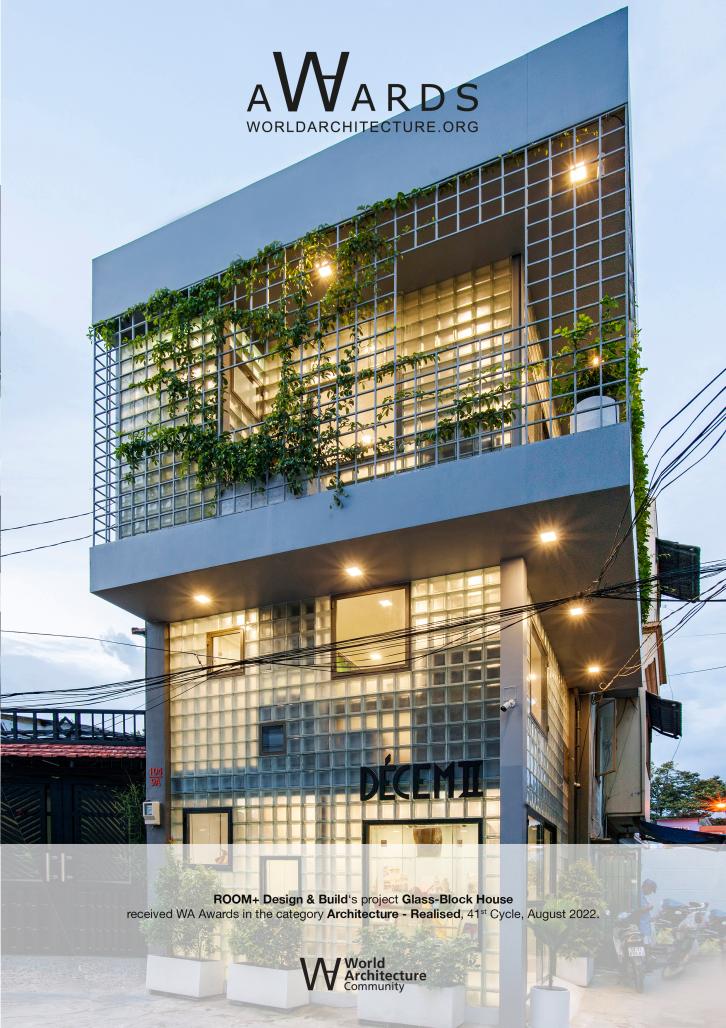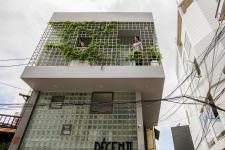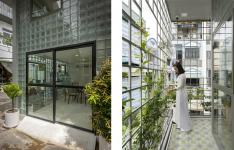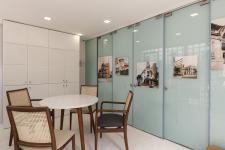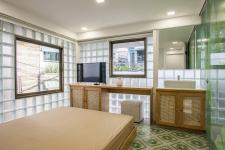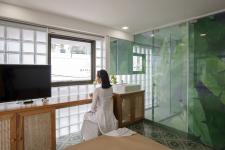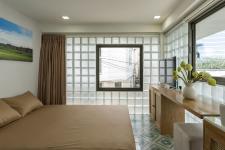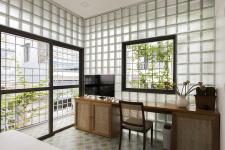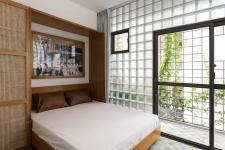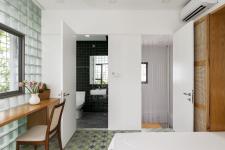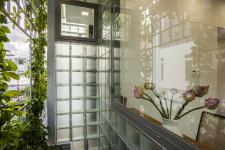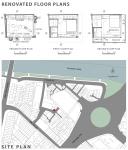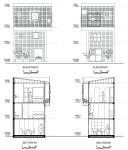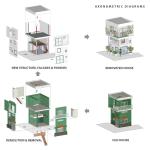An urban tiny house located at an 18-square-meter site in an alleyway has been renovated to fit the owner's needs. The old house was partly damaged and abandoned for months and very dark inside with brick walls and columns as the main load-bearing structure. The design brief asked for an affordable and artistic renovation to accommodate the owners’ start-up leather shop and their living space with two bedroom.
We proposed a creative solution by carefully removing two old brick facades then replace them with glass-block facades and integrated windows together with new minimal steel structure. The translucent glass-block facades on the North-East and South-East engage natural light and ventilation without losing the privacy, and also make the building blend with the surroundings during the day. At night, when lights on, the house become a magically sparkling lantern in the middle of the neighborhood.
The pergola on the top is a feature element of the built-form. The design of pergola is based on the square shape of the glass-block and considered as the outer skin of the façade which gives space for desirable plantings, enhances the privacy, and minimizes the heat gain to the interior space. The dimensions of the square windows are multiplied by the 190Wx190H mm dimension of a glass-block. The windows not only allow for natural light and ventilation but are also considered as connectors between the indoor space and the outside.
The service and circulation spaces including the bathrooms and staircases are positioned at the West to prevent solar heat gain getting into the main space. The ground floor is dedicated to the owners' leather showroom with some display windows and integrated glass shelving. The kitchen, laundry, staircase and a small toilet are purposely hidden behind sliding glass doors which are only opened when necessary.
The first level accommodates a compact bedroom suite with the bathroom and wardrobe seamlessly hidden behind glass partitions. The bedroom, bathroom, storage space, and furniture are altogether in a compact 14 square meter space. This space has merely two colors: the green of the traditional cement floor tiling and the banana-leaf patterned film applied on glass doors; and the neutral warm tone of the wooden furniture and soft furnishing.
The second level accommodates the cozy master bedroom suite with a landscaped balcony. The bathroom is a minimalist design featuring a delightful glass-block shower. The sunlight is filtered by the plantings as well as the translucent glass-blocks facades before lightening the interior space. The glass windows in various sizes are wisely positioned to open the view to the landscape yet avoid direct sight from the neighboring houses to enhance privacy and comfort.
The facades can be closed off thanks to the full-size roller blinds. The furniture is space-saving and carefully designed with natural wood and traditional bamboo sheets. The floors are finished with traditionally flora-patterned cement tile. The combination of contemporary and traditional materials in a minimalist approach makes one's spatial experience seem both freshly new and closely familiar at the same time.
We strongly believe that the project has proposed a uniquely creative design solution for the re-birth of the old house. By carefully investigating the existing conditions, respecting the context, accepting the challenging design brief, taking the risk and adding significant values to the asset, we has changed the once damaged and abandoned property into a uniquely creative example of micro house, which has become the most popular type of houses in the high-density urban context of Vietnam’s cities and other developing countries around the World.
Moreover, with this particular project, we have overcome the challenge of affordability. The client couple had a very tight budget and half of it has been lend from a bank. Therefore, we spent much of time and effort to preserve as many parts of the existing house as feasible to reasonably save the cost. We also proposed an idea that one of the new independent bedroom suites can be temporarily used as an AirBnB accommodation in order to add an income to the owners’ budget. This solution is not only for the design problem but also the challenge of affordability which most average-income people living in the cities have been facing with.
Last but not least, the renovation project has certainly added values to the neighborhood and also had a positive influence to the public. The neighbors have admired the house for its impressive appearance and the vibrancy it gives to the streetscape. The house plays an important role in making a sense of place at the local neighborhood thanks to its corner location and distinctive built-form. Moreover, many people told us that the Glass-block Micro House encourages them to be much more confident about renovating their tiny old houses, which they thought quite impossible and unaffordable for long.
2017
2018
Site area: 18 m2
Total floor area: 60 m2
Number of floors: 03
Building height: 8.3 m
Main structure: Steel frame, brick walls
Functions: Fashion shop, family home
Exterior finishes: Glass-block facades, iron frame – glass infill doors and windows, iron mesh pergola.
Interior finishes: Terrazzo floors, cement tiles, ceramic tiles, oak wood and MDF furniture.
Design firm: ROOM Design & Build
Design team: Vinh Phuc Ta (Project Leader), Casa Yen Nguyen, Hieu Hien Trinh, Kim Quy Nguyen
Construction: ROOM Design & Build
Photographer: Sonmeo Nguyen Art Studio
GLASS-BLOCK HOUSE by ROOM+ Design & Build in Vietnam won the WA Award Cycle 41. Please find below the WA Award poster for this project.

Downloaded 0 times.
